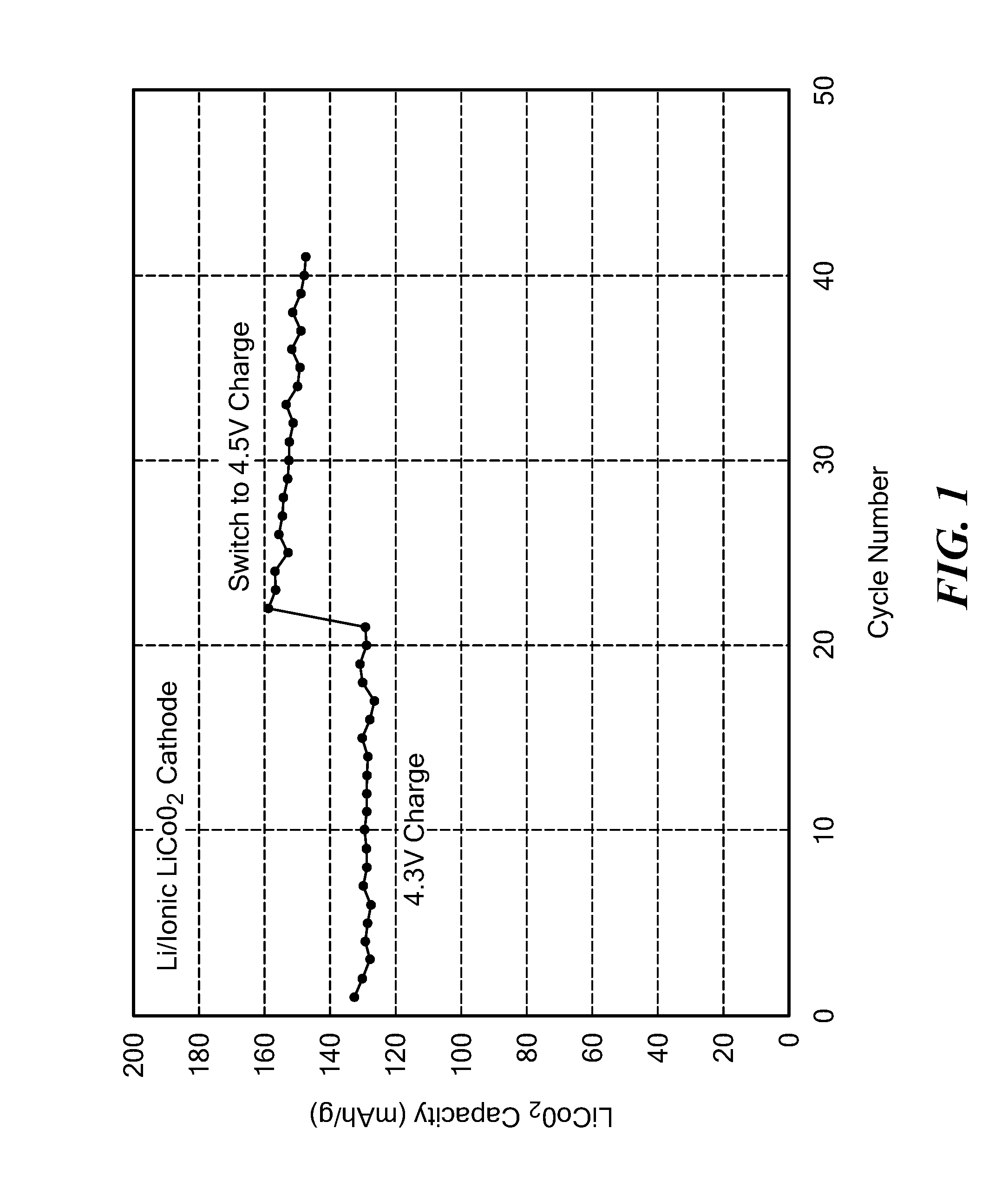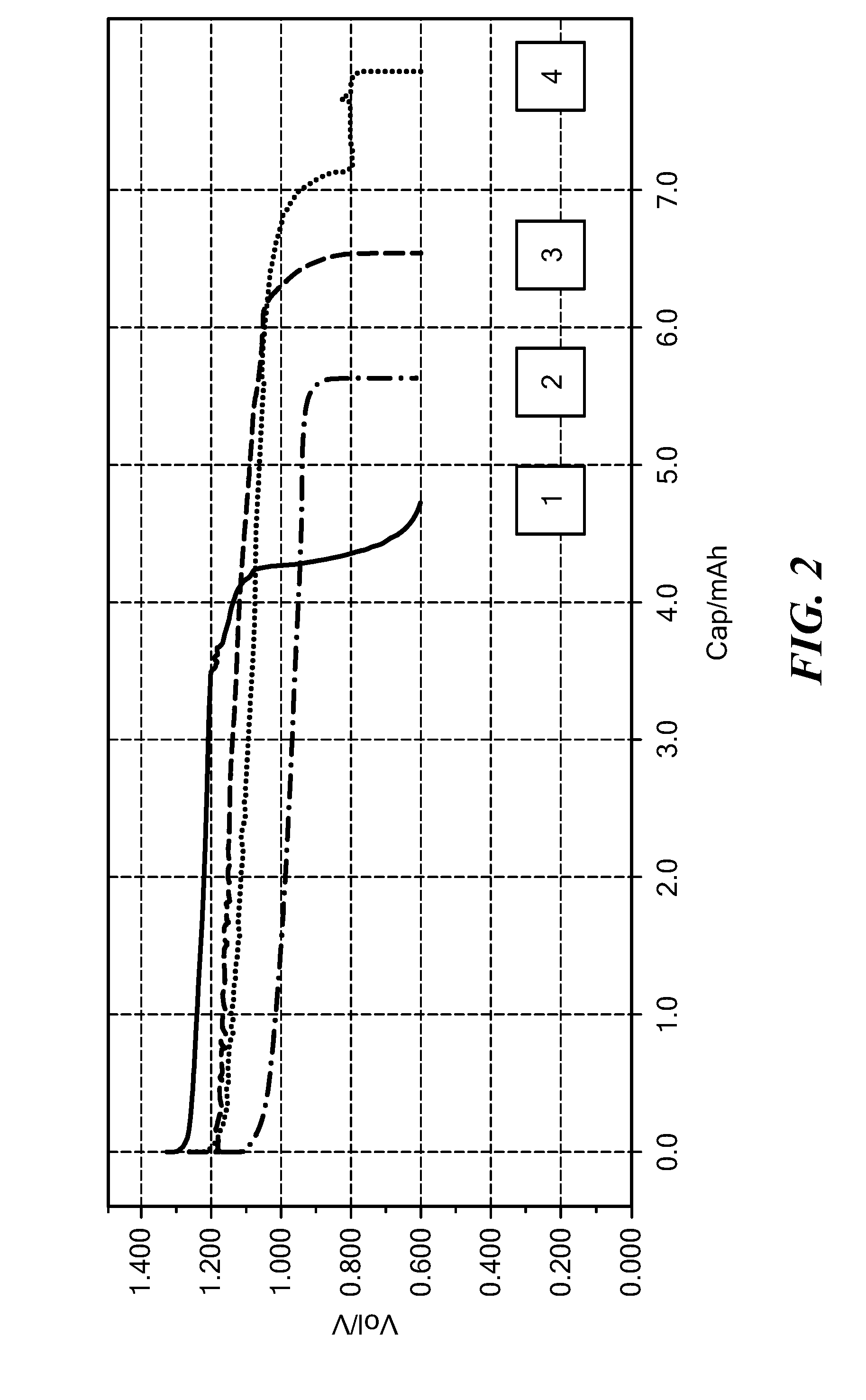Solid ionically conducting polymer material
a polymer material and solid ion technology, applied in the field of solid ion-conducting polymer electrolytes, can solve the problems of limiting the viability of end applications such as grid-level storage and mobile power, performance limitations and safety hazards, and the history of batteries has been slow and incremental improvements, so as to improve capacity and cycle life, low cost, and low cost
- Summary
- Abstract
- Description
- Claims
- Application Information
AI Technical Summary
Benefits of technology
Problems solved by technology
Method used
Image
Examples
example 1
[0166]PPS and chloranil powder are mixed in a 4.2:1 molar ratio (base polymer monomer to dopant ratio greater than 1:1). The mixture is then heated in argon or air at a high temperature [up to 350° C.] for twenty-four (24) hours at atmospheric pressure. A color change is observed confirming the creation of charge transfer complexes in the polymer-dopant reaction mixture. The reaction mixture is then reground to a small average particle size between 1-40 micrometers. LiTFSI is then mixed with the reaction mixture to create the synthesized solid, ionically conducting polymer material.
example 2
[0167]Lithium cobalt oxide (LiCoO2)(“LCO”) cathodes were prepared containing the synthesized material from Example 1. The cathodes used a high loading of 70% LCO by weight which is mixed with the solid ionically conductive polymer material and an electrically conducting carbon. Cells were prepared using lithium metal anodes, porous polypropylene separator and a standard Li-ion liquid electrolyte composed of LiPF6 salt and carbonate-based solvents. The cells were assembled in a dry glovebox and cycle tested.
[0168]The capacity in terms of the weight in grams of LCO used in these cells is displayed in FIG. 1. It can be seen that the capacity was stable when charged to 4.3 V, and consistent with the target of 0.5 equivalents of Li removed from the cathode during charging. The cell was also cycled to a higher charge voltage of 4.5V, which utilizes a higher percentage of lithium from the cathode, and resulted in the high capacity of >140 mAh / g. The slight drop in capacity with cycle numbe...
example 3
[0173]PPS polymer was mixed with the ionic compound LiOH monohydrate in the proportion of 67% to 33% (by wt.), respectively, and mixed using jet milling. DDQ dopant was added via vapor doping to the resulting mixture in the amount of 1 mole of DDQ per 4.2 moles of PPS monomer. The mixture was heat treated at 190-200° C. for 30 minutes under moderate pressure (500-1000 PSI).
[0174]Composite MnO2 Cathode
[0175]In this aspect of the invention related to manufacture of a solid ionically conducting polymer material—MnO2 composite cathode, the base polymer can be a semicrystalline having a crystallinity index greater than 30% or a fully crystalline polymer, and can be selected from a group which consists of a conjugated polymer or a polymer which can easily be oxidized with a selected dopant. Non-limiting examples of the base polymers used in this aspect of the invention include PPS, PPO, PEEK, PPA, etc.
[0176]In this aspect, the dopant is an electron acceptor or oxidant. Non-limiting exampl...
PUM
| Property | Measurement | Unit |
|---|---|---|
| melting temperature | aaaaa | aaaaa |
| ionic conductivity | aaaaa | aaaaa |
| cationic transference number | aaaaa | aaaaa |
Abstract
Description
Claims
Application Information
 Login to View More
Login to View More - R&D
- Intellectual Property
- Life Sciences
- Materials
- Tech Scout
- Unparalleled Data Quality
- Higher Quality Content
- 60% Fewer Hallucinations
Browse by: Latest US Patents, China's latest patents, Technical Efficacy Thesaurus, Application Domain, Technology Topic, Popular Technical Reports.
© 2025 PatSnap. All rights reserved.Legal|Privacy policy|Modern Slavery Act Transparency Statement|Sitemap|About US| Contact US: help@patsnap.com



